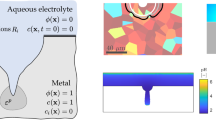Abstract—Non-point vacancy-gas defects (VGD) (pores, blisters) in the crystal lattice arise as a result of its irradiation with an inert gas Xe++, the process is considered as the formation of first-order phase transition nuclei by means of computational mathematics, kinetic theory, and the theory of stochastic dynamic variables and Wiener random processes. The characteristics of disordered porosity in samples consisting of layers (“dielectric/metal”) at various layer thicknesses are calculated. The formation of spherical shape defects in materials at times of the order of 10–4 s, when the porosity of the material nucleates, is preceded or accompanied by the appearance of microcracks. Irradiation of surfaces with an inert gas with ion energies of 5–10 keV refers to low-temperature blistering; in the model, the constancy of the influence of radiation fluxes stimulating a phase transition creates the condition of an “open” physical system in which it is possible to combine lattice defects into structures that cause local stresses, and the constancy of the temperature of the sample, the pressure of the implantable “monomers” of the gas, and supersaturation (similar to the parameters of vapor condensation) are characteristic of the fluctuation unstable stage of the phase transition move. Partial kinetic equations with nonlinear coefficients (Kolmogorov–Feller and Einstein–Smoluchowski) are solved by the method of stochastic molecular dynamics, which establishes a connection between the solution of Ito stochastic equations in the sense of Stratonovich and kinetic equations; stable numerical methods are used. The conditions for the formation of VGD are determined taking into account the influence of the elastic properties of the lattice, and the porosity and local stresses in thin layers of irradiated materials are calculated.
Similar content being viewed by others
REFERENCES
L. A. Golovan’, V. Yu. Timoshenko, and P. K. Kashkarov, “Optical properties of porous-system-based nanocomposites,” Usp. Fiz. Nauk 177, 619–638 (2007)
S. A.Kukushkin and A. V. Osipov, “Theory andpractice of SiC growth on Si and its applications to wide-gap semiconductor films,” J. Phys. D: Appl. Phys. 47, 313001-313043 (2014).
D. S. Wiersma, “Disordered photonics,” Nat. Photonics 7, 188–196 (2013).
Ch. Wu, M. S. Christensen, J.-M. Savolainen, et al., “Generation of subsurface voids and a nanocrystalline surface layer in femtosecond laser irradiation of a single-crystal Ag target,” Phys. Rev. B. 91, 035 413 (2015).
Y. S. Sigov, Computer Simulation: The Link Between Past and Future of Plasma Physics, Selected Works, Comp. by G. I. Zmievskaya and V. D. Levchenko (Nauka, Fizmatlit, Moscow, 2001) [in Russian]
G. I. Zmievskaya, “Fluctuaion Stage of Phase Transition,” in Encyclopedy of Low-Temperature Plasma, Ser. B, Ed. by V. E. Fortov, Vol. 7: Mathematical Simulation in Low-Temperature Plasma, Ed. by Yu. P. Popov, Book 3 (Yanus-K, Moscow, 2009), p. 28 [in Russian].
G. I. Zmievskaya, T. A. Averina, and A. L. Bondareva, “Numerical solution of stochastic differential equations in the sense of stratonovich in an amorphization crystal lattice model,” Appl. Numerical Math. 93, 15–29 (2015).
A. V. Skorohod, Stochastic Equations for Complex Systems (Nauka, Moscow, 1983) [in Russian].
L. Arnold, Random Dynamic System (Springer, 1998).
S. A. Kukushkin, “Initial stages of brittle destruction of solids,” Usp. Mekh. 2 (2), 21–43 (2003).
T. A. Averina, Statistical Modeling of Solutions of Stochastic Differential Equations and Systems with Random Structure (Izd. SO RAN, Novosibirsk, 2019) [in Russian].
G. I. Zmievskaya and T. A. Averina, “Fluctuations of a Charge on Melted Drops of Silicon Carbide During Condensation,” Preprint No. 280, KIAM RAN (Keldysh Institute of Applied Mathematics, Moscow, 2018).
G. E. Norman and V. V. Stegailov, “Molecular dynamics method: the concept and the reality,” Nanostruktury. Mat. Fiz. Modelir. 4 (1), 31–59 (2011).
A. A. Berzin, A. I. Morozov, and A. S. Sigov, “Light atom diffusion on a crystal surface and clusterization,” Phys. Solid State 38, 747 (1996).
A. I. Morosov, “Defecton Contribution to the High-Temperature Superconductivity of Hydrides,” Phys. Solid State 61 (7), 1176–1179 (2019).
G. Bruno, A. M. Efremov, A. N. Levandovskyi, et al., “Connecting the macro- and microstrain responses in technical porous ceramics: modeling and experimental validations,” J. Mater. Sci. 46, 161–173 (2011).
G. I. Zmievskaya and A. L. Bondareva, “Kinetics of the Formation of Pores and a Change in the Properties of Materials in Numerical Models,” J. Surf. Invest.: X-Ray, Synchrotron Neutron Tech. 10, 802–808 (2016).
G. I. Zmievskaya and A. L. Bondareva, “Numerical Simulation of Porosity Development Kinetics into Multy-Layer Media,” in Physical and Mathematical Models of Plasma and Plasma-Like Media. Selected Scientific Works, Ed. by G. Maino and G. I. Zmievskaya (Keldysh Institute of Applied Mathematics, Moscow, 2012).
G. I. Zmievskaya, “Computer Simulation of Phase Transition Nonequilibrium Processes,” in Nonequilibrium Processes, Ed. by S. M. Frolov, A. I. Lanshin, Vol. 1: Kinetics and Plasma (Torus Press, 2018), pp. 130–139.
A. V. Ivanov, “Using the Library aiwlib on the Example of Numerical Modeling of Stochastic Resonance,” Preprint No. 89, KIAM RAN (Keldysh Institute of Applied Mathematics, Moscow, 2018).
ACKNOWLEDGMENTS
The author is grateful to S. A. Kukushkin for the ideas for numerical modeling that his publications give and for the generosity with which he makes these works accessible.
Author information
Authors and Affiliations
Corresponding author
Additional information
Translated by I.K. Katuev
About this article
Cite this article
Zmievskaya, G.I. Stochastic Model of Pore Nucleation when the Sample is Irradiates with Inert Gas Ions. Mech. Solids 55, 114–123 (2020). https://doi.org/10.3103/S0025654420010215
Received:
Revised:
Accepted:
Published:
Issue Date:
DOI: https://doi.org/10.3103/S0025654420010215




